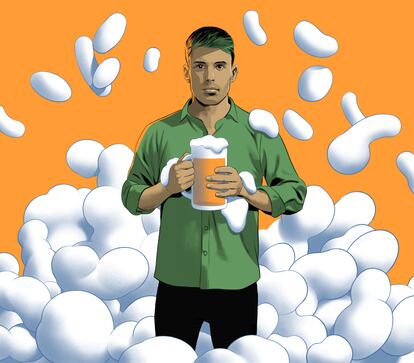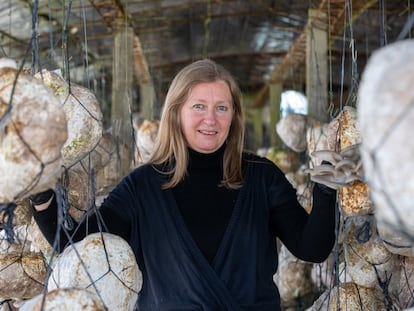Yeast, the fungus that kneads human beings
This microscopic organism has directed the evolution of our species for millions of years. An old traveling companion of humanity, it lies behind the invention of beer and bread

Among organisms formed by a single cell, there’s a basic division: those that have a differentiated nucleus where the DNA is located and those that don’t have a separate nucleus and, therefore, the DNA isn’t found within an internal membrane.
Among the first — microorganisms with a nucleus — the most common on a global scale is that of the Saccharomyces species. In Greek, this means “sugar fungus.” The most common is Saccharomyces cerevisiae, which has a long tradition of being used by our species. It’s what we use to make bread, beer and wine. However, if we really think about it, perhaps it’s the fungus that uses us.
One of the main characteristics of Saccharomyces is that it’s capable of using sugar to produce alcohol. Now, in principle, this would be a disaster. Alcohol is a molecule without a biological function — it’s extremely toxic and represents an incomplete oxidation of sugar. Hence, producing alcohol is a waste of energy. However, the fungus uses this alcohol production as a chemical weapon to eliminate competition from other microorganisms, since it’s resistant to alcohol while the rest of the microbes are not. This explains why it dominates many ecosystems: it’s a relentless killer.
There’s another obstacle to overcome. How can it survive winters in cold climates? Well, it seems that this fungus is capable of colonizing part of the digestive system of some species of wasps. In this way, it spends the winter taking advantage of the warmth of wasp nests. When spring arrives, the wasps transport these yeasts from flower to flower. There, once again, they display their evil tricks… but this time, in a more mysterious way.
The alcohol produced by yeast (as it digests sugar) has another use. It’s capable of solubilizing some of the volatile molecules produced by the plant, thus improving how its chemical signals are transmitted. This means that the plant colonized by Saccharomyces will be more successful, because it will be able to emit its signals at greater distances. Wasps will subsequently prefer to visit it, so a three-way relationship is created, making the yeasts beneficial for both the wasps and the plants. In a Machiavellian way, the fungus is cruel to its equals, but servile to superior organisms.
But there’s another characteristic of yeast that has influenced the evolution of our species. It’s found naturally in the skin of many wild fruits. This means that, when they mature and are loaded with sugars, the yeast begins to ferment and convert part of that sugar into alcohol. Numerous cases have been documented of animals that have a preference for consuming these fermented fruits, precisely because they’re trying to get drunk!
At a biochemical level, we’ve developed mechanisms to eliminate alcohol from the blood — mechanisms that we don’t have for other toxic substances that are lethal to us. This is an unequivocal sign that, throughout evolution, we’ve been exposed to the presence of alcohol, which has allowed us to develop enzymes. One example is the alcohol dehydrogenase, which is capable of oxidizing alcohol to neutralize its toxicity. Therefore, yeast has been able to direct the evolution of our species for millions of years, so that we choose the fruits that have fermented. This has caused natural selection to provide us with mechanisms to detoxify alcohol.
After millions of years of evolution, the human species invented livestock and agriculture. The first evidence of a fermented (and wild) grape juice is found in China, which would be the ancestor of wine. The Sumerians discovered a way to make beer, while the Egyptians discovered that, if they added the dregs left in the beer vats to the flour dough, it became more spongy and appetizing… hence inventing soft bread. In fact, the Egyptians were the first to trade in yeast, although they didn’t know that it was a living organism. They thought they had domesticated it, when the reality is that it was the yeast that had been influencing our evolution and domesticating us for millions of years.
From nature to the pantry
- Saccharomyces cerevisiae is the main fungus we use for food, but it’s not the only one. In warm countries, there’s a Schizosaccharomyces pombe yeast that’s found naturally in the skin of bananas and is used in some types of beer.
- In the preparation of kumis — or a drink made from fermented mare’s milk — in addition to the use of Saccharomyces, fungi of the genus Kluyveromyces and Candida are usually involved.
- Coffee, tea and chocolate — as well as many cheeses and yogurts — are also foods that require microorganisms in their production.
Sign up for our weekly newsletter to get more English-language news coverage from EL PAÍS USA Edition
Tu suscripción se está usando en otro dispositivo
¿Quieres añadir otro usuario a tu suscripción?
Si continúas leyendo en este dispositivo, no se podrá leer en el otro.
FlechaTu suscripción se está usando en otro dispositivo y solo puedes acceder a EL PAÍS desde un dispositivo a la vez.
Si quieres compartir tu cuenta, cambia tu suscripción a la modalidad Premium, así podrás añadir otro usuario. Cada uno accederá con su propia cuenta de email, lo que os permitirá personalizar vuestra experiencia en EL PAÍS.
¿Tienes una suscripción de empresa? Accede aquí para contratar más cuentas.
En el caso de no saber quién está usando tu cuenta, te recomendamos cambiar tu contraseña aquí.
Si decides continuar compartiendo tu cuenta, este mensaje se mostrará en tu dispositivo y en el de la otra persona que está usando tu cuenta de forma indefinida, afectando a tu experiencia de lectura. Puedes consultar aquí los términos y condiciones de la suscripción digital.
More information

What diseases are caused by fungi?









































